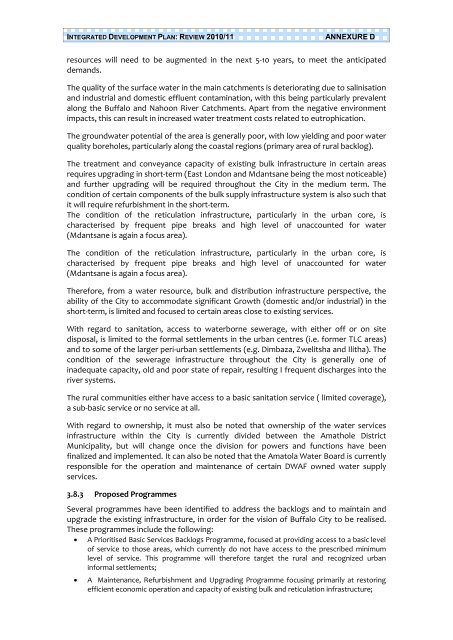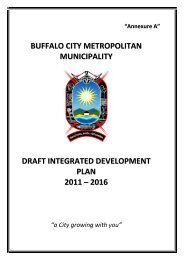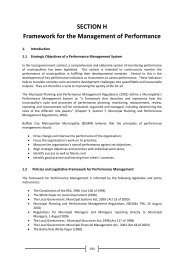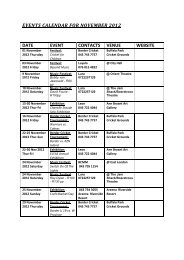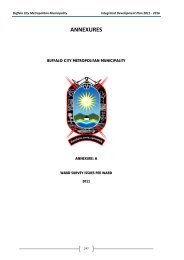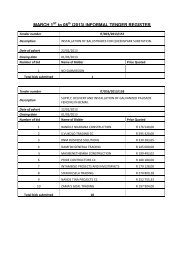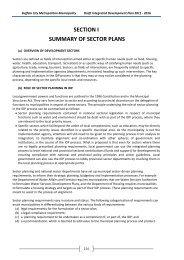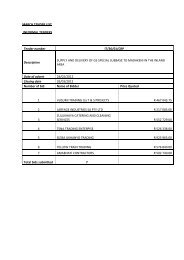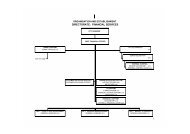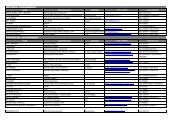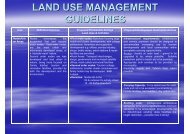annexure d executive summary of bcm sector plans - Buffalo City
annexure d executive summary of bcm sector plans - Buffalo City
annexure d executive summary of bcm sector plans - Buffalo City
You also want an ePaper? Increase the reach of your titles
YUMPU automatically turns print PDFs into web optimized ePapers that Google loves.
INTEGRATED DEVELOPMENT PLAN: REVIEW 2010/11ANNEXURE Dresources will need to be augmented in the next 5-10 years, to meet the anticipateddemands.The quality <strong>of</strong> the surface water in the main catchments is deteriorating due to salinisationand industrial and domestic effluent contamination, with this being particularly prevalentalong the <strong>Buffalo</strong> and Nahoon River Catchments. Apart from the negative environmentimpacts, this can result in increased water treatment costs related to eutrophication.The groundwater potential <strong>of</strong> the area is generally poor, with low yielding and poor waterquality boreholes, particularly along the coastal regions (primary area <strong>of</strong> rural backlog).The treatment and conveyance capacity <strong>of</strong> existing bulk infrastructure in certain areasrequires upgrading in short-term (East London and Mdantsane being the most noticeable)and further upgrading will be required throughout the <strong>City</strong> in the medium term. Thecondition <strong>of</strong> certain components <strong>of</strong> the bulk supply infrastructure system is also such thatit will require refurbishment in the short-term.The condition <strong>of</strong> the reticulation infrastructure, particularly in the urban core, ischaracterised by frequent pipe breaks and high level <strong>of</strong> unaccounted for water(Mdantsane is again a focus area).The condition <strong>of</strong> the reticulation infrastructure, particularly in the urban core, ischaracterised by frequent pipe breaks and high level <strong>of</strong> unaccounted for water(Mdantsane is again a focus area).Therefore, from a water resource, bulk and distribution infrastructure perspective, theability <strong>of</strong> the <strong>City</strong> to accommodate significant Growth (domestic and/or industrial) in theshort-term, is limited and focused to certain areas close to existing services.With regard to sanitation, access to waterborne sewerage, with either <strong>of</strong>f or on sitedisposal, is limited to the formal settlements in the urban centres (i.e. former TLC areas)and to some <strong>of</strong> the larger peri-urban settlements (e.g. Dimbaza, Zwelitsha and Ilitha). Thecondition <strong>of</strong> the sewerage infrastructure throughout the <strong>City</strong> is generally one <strong>of</strong>inadequate capacity, old and poor state <strong>of</strong> repair, resulting I frequent discharges into theriver systems.The rural communities either have access to a basic sanitation service ( limited coverage),a sub-basic service or no service at all.With regard to ownership, it must also be noted that ownership <strong>of</strong> the water servicesinfrastructure within the <strong>City</strong> is currently divided between the Amathole DistrictMunicipality, but will change once the division for powers and functions have beenfinalized and implemented. It can also be noted that the Amatola Water Board is currentlyresponsible for the operation and maintenance <strong>of</strong> certain DWAF owned water supplyservices.3.8.3 Proposed ProgrammesSeveral programmes have been identified to address the backlogs and to maintain andupgrade the existing infrastructure, in order for the vision <strong>of</strong> <strong>Buffalo</strong> <strong>City</strong> to be realised.These programmes include the following: A Prioritised Basic Services Backlogs Programme, focused at providing access to a basic level<strong>of</strong> service to those areas, which currently do not have access to the prescribed minimumlevel <strong>of</strong> service. This programme will therefore target the rural and recognized urbaninformal settlements;A Maintenance, Refurbishment and Upgrading Programme focusing primarily at restoringefficient economic operation and capacity <strong>of</strong> existing bulk and reticulation infrastructure;


